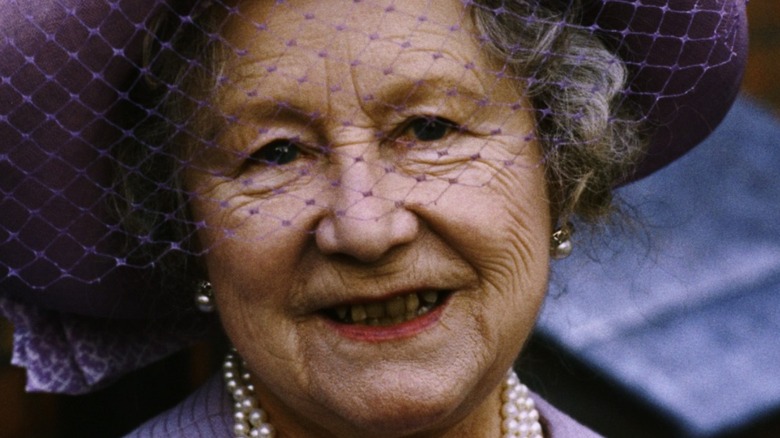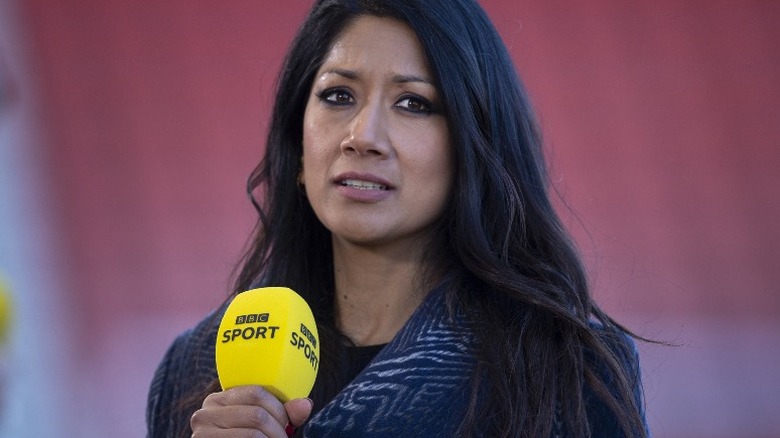The Queen Mother's Death Forced A Big Change To BBC's Wardrobe Policy
Following the death of Queen Elizabeth, the Queen Mother (above) on March 30, 2002, British newspapers were in a frenzy — over fashion. Specifically, the BBC's coverage of the event was called everything from disrespectful to amateurish to insensitive. The Guardian said the company was accused, at worst, of "betraying the nation and losing all right to call itself the national broadcaster" (via Slate). The problem? News anchor Peter Sissons' choice of tie. Whereas reporters on rival station ITV were wearing black ties to report the Queen Mother's death, Sissons was wearing a dark red one.
In addition to criticism from the newspapers, the BBC received around 130 complaints from viewers about their supposedly tactless coverage, with Sissons' interview of Margaret Rhodes, the Queen Mother's niece, being another point of controversy (via The Guardian). Sissons' friends defended him to The Times, saying he'd been told to wear that tie to match the BBC's new corporate color. The BBC replied that they had not banned mourning attire, according to Slate. The controversy led to some changes, nonetheless.
How did the BBC respond?
Independent reports that the BBC now practices for the deaths of major public figures, especially royalty, and that they always have black ties and suits available for reporters to change into. The BBC confirmed that report to Insider. The source also noted that news anchor Martine Croxall changed into a black jacket in a matter of minutes after announcing the death of Prince Philip last year. Mirror also confirmed that a specific dress code has been implemented in case of the queen's death. Male broadcasters will wear white shirts and black ties, while in general, reporters will wear dark-colored suits. Although the changes were made because of the negative public response to Sissons' clothing, the BBC noted after the Queen Mother's death that palace representatives said they had been satisfied with the BBC's coverage.
Ironically, former BBC editor Tim Luckhurst had predicted in The Guardian, less than a year before the Queen Mother's death, that coverage of a royal death would almost never be considered flawless, and whoever was on shift at the time it occurred would be blamed. He wrote, "Some poor hack, probably someone who has covered wars, revolutions, general elections and natural disasters without putting a foot wrong and simply by following good journalistic instincts, will be declared an un-person." The prediction was eerily correct for Sissons, who wrote in his memoir that he had never forgotten how the criticism hurt him (via Mirror).
Does the BBC have other dress code regulations?
Evidently the BBC now has dress code rules for reporting on royal deaths, but what are reporters expected to wear on a normal day? A leaked email in 2017 revealed a long list of dos and don'ts for BBC reporters. Samantha Smith, an editor and reporter for the BBC's "Inside Out South West" show, sent the email to other BBC employees. It included the advice to wear "somber clothing for reporting serious stories" (via Marie Claire U.K.).
Smith's list of acceptable clothes for BBC reporters included "smart" jackets, tailored suits, ankle-length pants, and simple makeup, according to Cosmopolitan U.K. Inappropriate clothing included fur, leather, short skirts (which she called "distracting"), and cardigans (which she deemed too casual) (via Marie Claire). She specified that reporters should avoid Marks & Spencer's Per Una brand — also too casual — and should keep their hair short, as it was "easier to cope with" (via Cosmopolitan). According to Marie Claire, there were also specific rules for different types of stories reporters might cover. Jeans, raincoats, and rain boots were inappropriate unless the story was about the countryside. Flip-flops were only appropriate for reporting from the beach. Sneakers were to be avoided unless the story involved running. Marie Claire reported, however, that a BBC spokesperson called this "informal advice," not actual rules for their reporters.
Has public opinion changed since 2002?
The BBC reported that it received 109,741 complaints about its coverage of the death of Prince Philip last year. Some objected to their inclusion of Prince Andrew in the coverage, given the criminal allegations against him. However, most were complaining that the coverage had preempted normal BBC programming, like the finale of "Master Chef." The company had received similar complaints after the Queen Mother's death.
However, the British public still takes an interest in the attire of BBC journalists. In August 2022, meteorologist Tomasz Schafernaker (above) received criticism — mostly via Twitter — because he was wearing sneakers with his suit on air. They were suddenly visible because of a new, full-length set. Before, he had been able to wear them without viewers knowing. According to Express, some people were "shocked" at the unprofessionalism of his shoe choice. One viewer tweeted, "looks like you've cycled in and forgot to pack your shoes."
Others, however, defended Schafernaker, saying his choice of comfortable shoes was "relatable." Schafernaker himself responded with humor, tweeting, "Busted!" He confirmed the shoes were "comfy" (via Express). Nonetheless, it seems that — as Smith wrote in her leaked email — clothing can be "a minefield of PC pitfalls" for BBC reporters (via Marie Claire U.K.).



